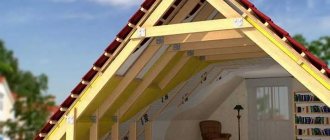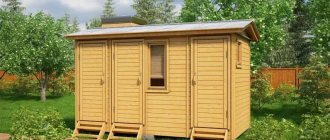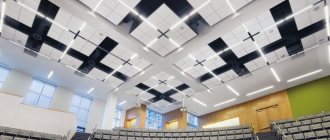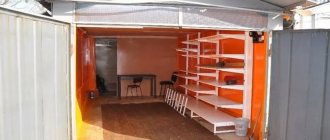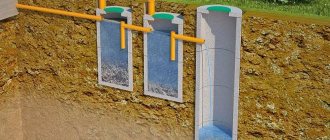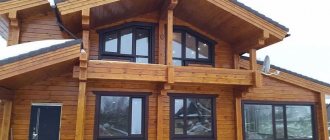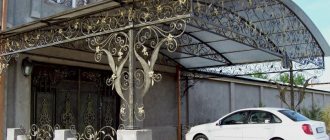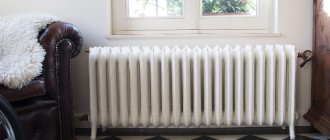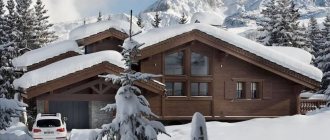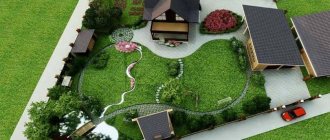When considering various roofing options for their home, many owners choose a sloping roof. This article offers information about the features, pros and cons of the design, as well as about the different types of sloping roofs. After reviewing the proposed material, you will get an idea of the calculation of the roofing system, installation technology and the reasons for the economy of such systems.
House with an attic under a sloping roof Source pinterest.ru
Broken roof: device features
The trend in modern construction is the desire to increase the functionality of a home without losing its visual appeal. The broken structure fully meets these needs: it not only transforms the appearance of the building, but also allows for rational use of the under-roof space. For this reason, despite the increasing complexity of the structure, broken roofs are increasingly decorating country cottages.
A sloping roof is a derivative of the usual gable roof. Unlike the latter, each slope of a broken structure has a bend line along which the angle of inclination changes. Thanks to this detail, the number of slopes doubles, and the pediment (the side vertical surface between the slopes, usually triangular in shape) becomes pentagonal. This change is reflected in the rafter system of the sloping roof. It becomes more complex, lower and upper rafters appear, and the roof is characterized by the following parameters:
- Lower rafters. Set a steeper angle, no less than 60°.
Schematic diagram of a sloping roof Source mirhat.ru
- Upper rafters. For them, an angle of about 30° is selected.
- Location of the ramps. The support for the slopes can be the walls of the building or floor beams extended beyond the walls.
All these changes are needed in order to maximize the attic area. The resulting space is usually used to equip the attic, which is why this design is called an attic roof. A house with a sloping roof and a veranda, common in private housing construction, is considered the most comfortable for living; the roof in such buildings is equipped with the following additional elements:
- Window. Energy-saving windows with safety double-glazed windows (with internal laminated triplex glass) are relevant.
Windows of various types in a sloping roof Source pinterest.es
- Balcony or terrace. A good way to increase the level of comfort and usable area of the attic. The decision to acquire this spectacular detail will require a more complex design and additional strength calculations.
House with a terrace on the attic floor Source makika.ru
- Bay window. An original architectural solution that decorates the building and also expands the living space. Usually they try to glaze the bay window to the maximum in order to increase the natural light of the attic.
House with a bay window Source klub-masterov.ru
- Cuckoo. This piece got its name because of its resemblance to the famous wall clock. The cuckoo has a separate rafter system connected to the main one. The shape distinguishes between single and gable structures, as well as hip and arched ones; the latter can be found on houses in the style of an Alpine chalet.
Gable cuckoo Source memphite.com
Types of rafter systems
The structural performance of the attic directly depends on the configuration of the roof. Therefore, rafter systems for this type of roof can be divided into the following types:
- Single-pitch is the cheapest and simplest option.
This system involves the creation of one roof slope, which rests on walls of different levels. To ensure the strength of the structure, it is recommended to maintain a tilt angle of 35° to 45°, otherwise in winter the accumulated snow will put a strong load on the load-bearing walls. If the distance between opposite walls is a maximum of 4.5 m, then there is no need to install additional supports. If this indicator is exceeded, then supports are required, otherwise the building will be subject to deformation. Read more about the correct fastening of rafters when installing a pitched roof here. - A gable roof is not a very complicated option for arranging a roof.
The peculiarity is that the roof itself must be high so that it is convenient to arrange a living space under it. Considering the location of the ridge, such a roof can be symmetrical or asymmetrical. The disadvantage of such a system is that due to the configuration of the roof, most of the free space remains non-residential (the upper part of the roof and areas near the wall). - Three-slope. Feature - 2 parts of the roof will be located at different slopes relative to the floor beams.
But this design allows you to make maximum use of the available space. As a result, the living area of the room will be only 10-15% less than the area of the room located on the floor below. And the ceiling height will also be the same - within 2.1-2.3 m. - Four-slope is the most difficult option. It allows you to use the space under the roof with minimal loss of living space. But it is worth considering that this rafter system requires more insulation and roofing.
Please note: due to the correct slope of the slopes, snow will not accumulate on the roof in winter, but still the heaviest load will be placed on the layered rafters, so it is important to think about this point when making calculations.
Broken roof: advantages and disadvantages
Before making a choice in favor of this roof, it is worth getting acquainted with its pros and cons. The advantages include the following qualities:
- You get additional living space, which is especially valuable for small areas where you have to save every meter of territory.
- You get a room of a convenient shape, in which (unlike a gable roof) large furniture can easily be placed. If desired, additional hidden cabinets can be placed in dead zones (between the slopes and walls).
- An attic is cheaper than building a full second floor or expanding the perimeter of the housing.
- A well-designed attic reduces heat loss, which means saving energy resources.
- The appearance of a private house with a sloping roof is superior to a classic gable roof.
Sloping roof in a classic style Source 123rf.com
The negative aspects of a sloping roof include the following facts:
- Finance. A sloping roof will cost more than a gable roof, since it will require more wood and materials for the roofing pie.
- Restrictions on Use. Such a roof is not the best solution for regions with snowy winters. Snow on sloping windows prevents sunlight from entering the attic. If the roof is designed incorrectly, snow gets clogged under the ridge or on the break line of the slopes and accumulates inside.
- The importance of ventilation. Lack of ventilation leads to the accumulation of condensation in the thermal insulation layer and accelerated wear of the rafter system.
Tips for work
When installing a broken-type attic roof, you need to remember the following recommendations:
To give the structure maximum strength and reliability, the height of the attic should not be more than 2.2 m.- Ventilation should be carried out from the eaves overhangs to the ridge itself to prevent condensation.
- If you subsequently plan to expand the attic area, this must be taken into account when designing and calculating the loads on the walls.
- Since the roof consists of almost 70% wood materials, they must be pre-treated with special protective compounds.
- All roof elements must have a minimum weight so as not to place additional load on the load-bearing walls and foundation.
Attic under a sloping roof: profitable or not
At first glance, installing an attic floor under a sloping roof is a profitable venture, since you can save on the construction of walls and at the same time gain additional space. This statement is half true; The savings will be spent on other components, which include:
- Rafter system. To build a sloping roof from boards and other lumber, it is necessary to estimate the cost of the structure. The final estimate will be affected by the type of structure you choose and local lumber rates. The best choice would be softwood lumber with a moisture content of 18–22%.
- Components of a roofing pie. If you are planning a residential attic, you won’t be able to save on insulation, hydro- and vapor barriers. To maintain the proper temperature in the room, you will need a decent insulating layer (SNiP standards for the European part of Russia require a layer of mineral wool from 20 cm).
What materials are needed?
To build a sloping roof with an attic you need:
- Timber for the rafter system, mauerlat, purlins - it is better to take coniferous wood, such as pine or spruce.
- Edged boards - for rafter legs.
- Boards - for sheathing.
- Slats - for counter-lattice.
- Thick plywood - as fasteners for the joints of the rafter legs.
- Fire retardants, fire protection, antifungal treatment, antiseptic impregnation.
- Insulation (which is better to use for an attic roof?).
- Waterproofing and vapor barrier material.
- Sealant.
- Roofing covering.
- Fastenings, brackets, screws, brackets.
Video description
About the house with an attic and a balcony in the following video:
- Window. Two types of window packages are used - vertical and in the plane of the roof. Windows located at an angle are one and a half to two times more expensive than windows in a house; they are equipped with a reinforced rotating frame and glass that can withstand snow cover. Their installation will also cost more, since it is necessary to ensure the tightness of the openings and think about snow guards over each window. Dormer windows will require a separate rafter system, which complicates the roof topography and makes installation more expensive.
- Choosing a roofing covering. Popular metal-based materials (metal tiles or corrugated sheets) are not the best choice for arranging such a structure. Metal-clad roofing is characterized by high thermal conductivity and a strong drum effect in rainy weather. These features will force you to use additional heat and sound insulation, which, quite expectedly, will lead to additional expenses.
Dormer windows are designed for ventilation or access to the outside Source eadone.org
It may seem that building a sloping mansard roof is not as cheap an option as it seemed at first. However, real savings still exist and look like this:
- Saving on foundation. Since the attic floor is lighter than a full floor, the foundation is laid less powerful than for a two-story house. Since the cost of the foundation can be up to 25-30% of the construction cost, the gain will be tangible.
- Saving on roofing material. By purchasing more expensive roofing, you can save on the filling of the roofing pie; However, for this you will have to calculate more than one option.
- Delayed construction. Often high humidity lumber is purchased for the rafter system. If the roof is assembled right away, moisture will begin to be absorbed into the heat-insulating layer, which is not dangerous for a properly assembled pie, but will cause problems for a roof that is made incorrectly. Delaying commissioning will allow the wood to dry out properly, which will reduce the number of problems in the future.
Main stages of construction
The construction of a sloping roof with an attic involves going through 8 stages of construction:
- Installation of the Mauerlat on a layer of waterproofing (roofing felt) and floor beams.
Fixing vertical posts to floor beams.- Installation of lower rafters.
- Installation of the upper rafters.
- Fixation of struts, ties and additional supports - to add strength to the structure.
- Stuffing counter battens and sheathing.
- Installation of the final roofing covering.
- Creation and cladding of gables.
After installing the rafter system, you can proceed to insulating the attic roof and arranging ventilation. As a vapor and waterproofing, you can use a “breathing” membrane, which is mounted continuously to avoid the possibility of moisture penetrating into the room, and fumes from entering the insulation from the room.
Please note: the vapor barrier material is installed from the inside of the roof, and the waterproofing material is installed under the roofing.
Since the membrane will overlap, it is important to seal the joints with special tape. The insulation can be stone wool, which is quite easy to install and cut into the required slab sizes.
It is important not to forget about the ventilation gap between the insulation and the finishing roofing covering, and about special ventilation passages in the eaves and ridge. For flat roofing material, the ventilation gap must be at least 50 mm, and for profiled roofing material - at least 25 mm.
Read more about how to properly build an attic roof with your own hands in a separate article.
Nuances of calculating the attic roof
Roof calculation solves several problems:
- Calculation of the rafter system during construction. It is especially important if there are additional details - windows, balconies, access to the roof, terraces. Such parts increase the load on the rafters, and the design needs to be adjusted.
- Calculation of the rafter system during reconstruction. Converting a non-residential attic into an attic is limited by the size of the existing building. All load-bearing elements will require a competent calculation of their cross-section.
- Calculation of building materials. To ensure that the construction of the roof is not slowed down due to a sudden shortage of timber, metal tiles or self-tapping screws, the required amount of materials is first calculated.
Calculation diagram for a sloping roof Source stroicod.ru
The procedure for calculating a sloping roof is as follows:
- is calculated . The linear dimensions of each slope are measured; The area is determined (by multiplying the length and width). The final number is the sum of the areas of all slopes.
- is calculated .
- is calculated . To do this, the average snow and wind load that the structure can receive during the season is determined.
The Internet offers an online calculator for calculating the rafter system of a sloping roof. As a rule, it allows you to calculate the slope angles, sheathing parameters, permissible load and the required amount of roofing material. The result is based on the following parameters:
- Laying width (projection of the inclined slope onto the base) of each element.
- The rise height (distance from the top of the slope to the base of the roof) of each slope.
- Length of base and overhangs.
- Roofing material (weight taken into account).
Design rules, drawings
When designing, you need to take into account the dimensions of the roof building, and it is also important to calculate the correct angle of inclination of the roof, which depends on the following factors:
- Wind forces in a given area. The territory of Russia is divided into 8 zones according to wind load. This indicator must be taken into account, otherwise an incorrect angle of inclination will lead to the fact that the wind will get under the joints of the roofing and undermine it.
- Snow loads. Based on this indicator, Russia was also zoned into 8 zones. Since the roof is sloping, the upper and lower slopes will have different slopes.
- Type of roofing. For bitumen shingles, an angle of more than 30° is allowed, for tiles and metal profiles - 22°, and for slate - 30°.
- Precipitation intensity in a given region. Where it rains very often and winters are very snowy, the optimal inclination angle is 45°, and for areas with a temperate climate, 30° is sufficient.
When making a roof project, it is better to draw up drawings with different projections of the structure. Thanks to this, you can see the arrangement of elements from different sides.
To make accurate calculations, it is important to take seriously the initial measurements of the length and width of the house, and then observe the scale on the drawings. Find out more about calculating the design of a mansard roof here.
The project should take into account:
- The height of the ridge connection - the height of the ceilings depends on it. There should be a distance of about 1.5 m from the ridge to the ceiling.
- Ceiling height. The optimal value is a level of 2-2.2 m.
- The slope of the upper slopes is from 20° to 30°.
- The slope of the lower slopes is from 50° to 60°.
- Dimensions of walls and their area.
Tip: To make drawing easier, you can use computer programs. With their help, it is enough to enter only the dimensions of the house and the desired type of roof, the program will calculate everything else automatically.
Assembly
In most cases, the construction of an attic roof begins with the installation of a Mauerlat
What is important is a strictly horizontal position, parallel, reliable fastening of its beams
Rafter structure of a mansard roofSource kryshagid.ru
For the installation of a rafter system, two options are practiced: the elements of the rafter system on the ground are assembled into trusses, lifted and installed ready-made. Or everything is assembled separately at the top - “in place”, following the order of actions:
- Floor beams are being laid. This takes into account the pitch of the rafter system and the possibility of installing a staircase.
- A rough ceiling or temporary flooring is immediately laid for safe work.
- Racks are installed. Temporary braces are installed to keep them in an upright position. Purlins are laid on the racks.
- Puffs are laid on top of the purlins.
- The lower rafters are installed.
- Temporary braces are replaced by permanent wind braces in a longitudinal position.
- The upper rafters are installed.
- The frame for the pediment is set up, taking into account the design, openings are organized for: windows, balconies, and other options are provided.
- Next, a roofing membrane is laid along the rafters and pressed against them with a counter-lattice - bars with a cross-section of 50x50 mm. To organize a ventilation gap. These are preparatory measures for insulation. They need to be carried out precisely at this stage. To miss it is a huge omission.
- The sheathing is placed on the counter-batten, with a pitch corresponding to the roof covering.
- The roof covering and its additional elements are installed: wind boards, ridge.
The same house can look different and have different usable areaSource 1dom.kz
About the features of calculating a mansard roof in the video:
Lathing
The sheathing can be solid or lattice.
Solid
Continuous sheathing is made in most cases from boards, which completely cover the space between the rafter legs, screwing them to the latter using self-tapping screws on metal plates. Necessary for flexible roofing materials.
Lattice
The lattice option is the most common. It implies that horizontal rafters are laid at a certain distance from each other. The latter depends on the type of coating. In this case, beams with a smaller cross-section than the rafter legs are used.
Varieties
All mansard roofs can be classified into 4 categories, each with different designs. Moreover, such attics can be single-level or two-level. It is easier to build a one-level attic. As a rule, this design involves the construction of a conventional gable or sloping roof.
Two-level attics are more difficult to construct. This design involves the construction of 2 rooms at different levels. In this case, the method of combining supports is used.
In the photo of the attic roof you can clearly see the design options for such structures. Additionally, a balcony can be provided. It is constructed by analogy with a window opening.
But this possibility depends on the load-bearing capacity of the walls. If it is not enough, a balcony can be built using additional supports.
Frame extension
Typically, the load-bearing structures of frame extensions are sheathed with decorative slabs. This type of extension has the following advantages:
- they are relatively light;
- they can be quickly assembled;
- good price.
Voids in frame extensions are filled with foam or mineral wool.
